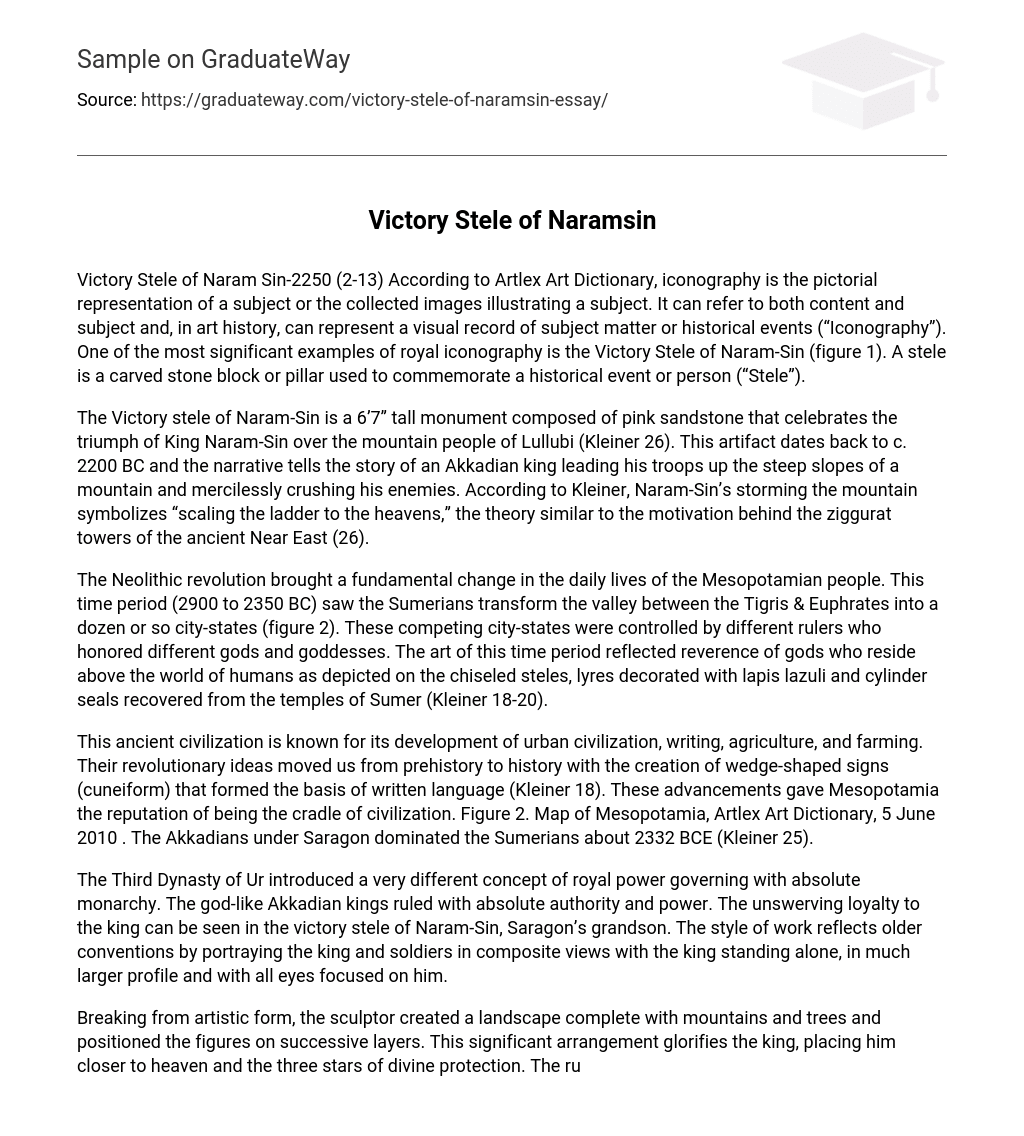Victory Stele of Naram Sin-2250 (2-13) According to Artlex Art Dictionary, iconography is the pictorial representation of a subject or the collected images illustrating a subject. It can refer to both content and subject and, in art history, can represent a visual record of subject matter or historical events (“Iconography”). One of the most significant examples of royal iconography is the Victory Stele of Naram-Sin (figure 1). A stele is a carved stone block or pillar used to commemorate a historical event or person (“Stele”).
The Victory stele of Naram-Sin is a 6’7” tall monument composed of pink sandstone that celebrates the triumph of King Naram-Sin over the mountain people of Lullubi (Kleiner 26). This artifact dates back to c. 2200 BC and the narrative tells the story of an Akkadian king leading his troops up the steep slopes of a mountain and mercilessly crushing his enemies. According to Kleiner, Naram-Sin’s storming the mountain symbolizes “scaling the ladder to the heavens,” the theory similar to the motivation behind the ziggurat towers of the ancient Near East (26).
The Neolithic revolution brought a fundamental change in the daily lives of the Mesopotamian people. This time period (2900 to 2350 BC) saw the Sumerians transform the valley between the Tigris & Euphrates into a dozen or so city-states (figure 2). These competing city-states were controlled by different rulers who honored different gods and goddesses. The art of this time period reflected reverence of gods who reside above the world of humans as depicted on the chiseled steles, lyres decorated with lapis lazuli and cylinder seals recovered from the temples of Sumer (Kleiner 18-20).
This ancient civilization is known for its development of urban civilization, writing, agriculture, and farming. Their revolutionary ideas moved us from prehistory to history with the creation of wedge-shaped signs (cuneiform) that formed the basis of written language (Kleiner 18). These advancements gave Mesopotamia the reputation of being the cradle of civilization. Figure 2. Map of Mesopotamia, Artlex Art Dictionary, 5 June 2010 . The Akkadians under Saragon dominated the Sumerians about 2332 BCE (Kleiner 25).
The Third Dynasty of Ur introduced a very different concept of royal power governing with absolute monarchy. The god-like Akkadian kings ruled with absolute authority and power. The unswerving loyalty to the king can be seen in the victory stele of Naram-Sin, Saragon’s grandson. The style of work reflects older conventions by portraying the king and soldiers in composite views with the king standing alone, in much larger profile and with all eyes focused on him.
Breaking from artistic form, the sculptor created a landscape complete with mountains and trees and positioned the figures on successive layers. This significant arrangement glorifies the king, placing him closer to heaven and the three stars of divine protection. The ruler wears a horned helmet (shown in frontal view on a profile head) typically reserved only for gods. The troops march up the mountain orderly and faithfully, while the defeated enemy is shown in disarray and submission.
The style and iconography of this work reflect the new concept of royal power the Akkadians brought to Mesopotamia in the 3rd millennium BC. The Akkadian rulers were the first to call themselves kings of the world and to assume divine attributes. This ideology is manifested in Naram-Sin’s stele where his victorious ascension has been chiseled in stone, celebrating a sovereign who considers himself on an equal footing with the gods. Nara-Sin’s title was “King of the Four Quarters,” meaning “ruler of the World” (Kleiner 25).
This typifies the social and religious beliefs during the Akkadian rule during the Third Dynasty of Ur. Works Cited “Iconography. ” Artlex Art Dictionary. n. d. Web. 5 June 2010 . Kleiner, Fred. Gardner’s Art through the Ages: The Western Perspective. 13th ed. Vol. I. Boston: Wadsworth, 2009. Print. “Stele. ”Artlex Art Dictionary. n. d. Web. 5 June 2010 . ———————– Figure 1. Victory stele of Naram-Sin. Susa Iran, 2254-2218 BCE. Louvre, Paris. Kleiner, Fred. Gardner’s Art through the Ages: The Western Perspective. 13th ed. Vol. I. Boston: Wadsworth, 2009 Pg . 26





